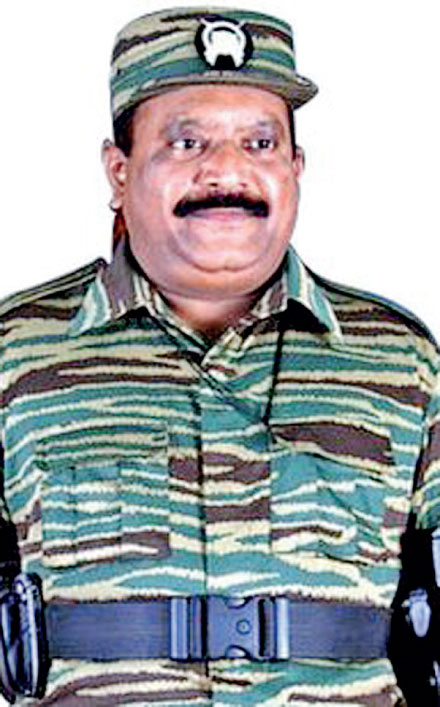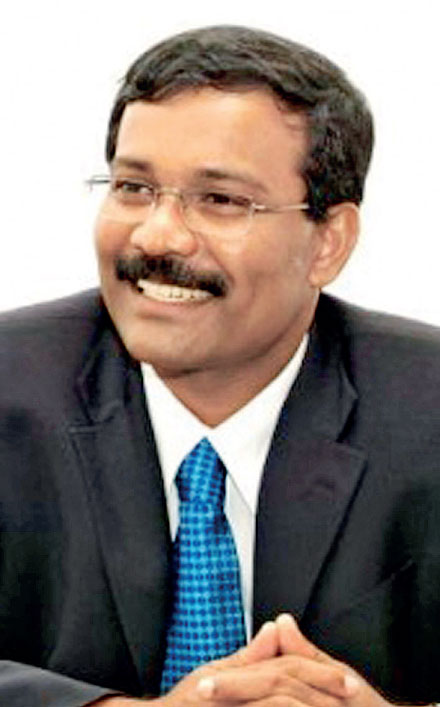Monday Apr 07, 2025
Monday Apr 07, 2025
Wednesday, 2 November 2022 02:22 - - {{hitsCtrl.values.hits}}

Velupillai Prabakharan

Thamilselvan
 Fifteen years ago on 2 November 2007, the former political wing chief of the Liberation Tigers of Tamil Eelam (LTTEE), Thamilselvan (spelled also as Tamilselvan and Thamilchelvan) was killed along with some other tiger operatives in an airstrike conducted by the Sri Lankan Air Force (SLAF). The incident grabbed worldwide attention when it happened because Thamilselvan was to a very great extent the public and political face of the LTTE in those days.
Fifteen years ago on 2 November 2007, the former political wing chief of the Liberation Tigers of Tamil Eelam (LTTEE), Thamilselvan (spelled also as Tamilselvan and Thamilchelvan) was killed along with some other tiger operatives in an airstrike conducted by the Sri Lankan Air Force (SLAF). The incident grabbed worldwide attention when it happened because Thamilselvan was to a very great extent the public and political face of the LTTE in those days.
Four-year-old Thamilselvan was killed along with five other tiger cadres in the early hours of the morning on Friday 2 November 2007. Subsequently another injured tiger also died. Two jet bombers, an Israeli K-fir and a Russian built MIG-27 had engaged in aerial bombardment at first light between 5.55-6 a.m. The target area was suburban Thiruvaiyaaru about three km from Kilinochchi town in the Wanni region controlled extensively by the tigers at that time.
Thamilselvan’s death in the SLAF air strike caused shock waves at that time. It was regarded as a great blow to the LTTE in general and tiger leader Prabahkaran in particular. It is against this backdrop that this column revisits the killing of Suppiah Paramu Thamilselvan or SP Thamilselvan on the 15th death anniversary of the former tiger political commissar.
Proud Moment for the SLAF
The successful airstrike was a proud moment for the Sri Lankan Air Force then commanded by Air Marshal Roshan Goonetilleke. A few weeks earlier on 22 October 2007 the SLAF Air Base at Saliyapura in Anuradhapura had been attacked by an LTTE “Black Tiger” squad. Several Air Force personnel and LTTE cadres were killed.
Around 20 Aircraft of different types were reportedly destroyed. It was a dark day for the SLAF and morale was low. But the Air Force struck back in 11 days. The SLAF seemingly made amends for the Saliyapura debacle and redeemed its image in the eyes of the people by successfully targeting the top -notch tiger.
Thamilselvan was posthumously promoted in rank as “Brigadier” by LTTE supremo Prabhakaran. He was the first tiger to be made Brigadier.
LTTE political commissar Thamilselvan frequently represented the LTTE at negotiations with national and international delegations, issued press statements, granted media interviews and engaged in talks with dignitaries on behalf of the tigers. Since the LTTE’s reclusive numero uno Velupillai Prabahkaran and other senior military leaders usually kept out of the limelight, it had been the lot of Thamilselvan to exercise a monopoly over media publicity.
The LTTE and its overseas supporters were greatly upset. Many events mourning his death were organised. The majority of Sri Lankans however were happy and jubilant. Many in the southern provinces of the Island ecstatically lit crackers when they heard the news. Spontaneous celebrations were held.
Buried at Kanakapuram
The other tigers killed along with Thamilselvan in the Thiruvaiyaaru bombing on 2 November were Muthukkumaru Soundarakrishnan alias Lt. Col. Anpumani ,Dharmarajah Vijayakumar alias Major Mikunthan, Karunanidhi Vasanthakumar alias Capt. Kalaiyarasan, Panchatcharam Sajeeban alias Lt. Aatchivel and Muthukkumaarakkurukkal Srigayathrinatha Sarma alias Lt. Maavaikumaran Sivalingam Aathavan alias Major Selvam who was critically injured in the bombing passed away on November 9th and was buried with full military honours at Kanakapuram great heroes cemetery along with the others.
Thamilselvan who had been functioning from 1994 as the LTTE’s political commissar had been assigned additional quasi-military duties in 2007. He was placed in charge of defences at Pooneryn as he was familiar with the area. Thamilselvan had been at Pooneryn for three days at a stretch from 29 October to 1 November in 2007.
He returned to Kilinochchi town on 1 November afternoon. Kilinochchi was the place where the LTTE’s political headquarters, peace secretariat and strategic communications unit were located in those days. It was in a sense the unofficial capital of LTTE controlled territory then.
Thamilselvan’s last official duties were at the communications unit from where he contacted several persons in Sri Lanka and abroad. Some well-wishers brought specially cooked food including mutton curry. The tiger political commissar and others stayed late into the night at the place, partaking of food and engaging in conversation.
Bunker Located in Thiruvaiyaaru
Thereafter at about 2.30 a.m. the tigers moved to a safe bunker located in Thiruvaiyaaru. Given the prevailing security situation important tiger leaders used to sleep at night in well-fortified bunkers away from their homes. They also avoided sleeping at the same place on successive nights.
The “L” shaped bunker was well camouflaged. It had lower and upper compartments. Thamilselvan went to bed in the lower one while the others slept in the upper one. The two jet bombers came at first light and discharged their lethal cargo effectively. Subsequently three other planes (2 MiG;s and 1 K-fir) also dropped nine bombs from 6.20 a.m. to 6.30 a.m. in the South of Kilinochchi in the area around the 155th milepost and St. Anthony’s church. Two civilians were killed and six injured.
The first aerial mission had been bullseye on target when a bomb fell on the entrance of the bunker. There was a massive explosion and the entire structure collapsed and caved in. As stated earlier six tigers including Thamilselvan were killed in their sleep. The seventh died days later of injuries.
Among top tiger leaders to reach the spot early were the then Tiger Intelligence Chief Pottu Amman and Pappa head of the LTTE sports division. The destruction was so immense that a bulldozer was brought first to facilitate excavation. Thereafter the bodies were dug up manually. Most LTTE bunkers are strong and designed to withstand aerial bombardment. What troubled the LTTE then was the thought that a giant bomb had knocked out Thamilselvan’s bunker.
“Raatchathakkundu” or Giant Bomb
The LTTE accused the Government headed by President Mahinda Rajapaksa of having spurned peace moves by dropping a giant bomb and killing the “peace dove” Thamilselvan. “The Sinhala nation did not open its heart and send a peace message. On the contrary, it is sending war-vultures that are dropping giant bombs. It has cruelly killed our peace dove.”
The above sentences excerpted from Velupillai Prabakharan’s statement released after Thamilselvan’s death denote the concern of the LTTE about a “giant bomb”. The LTTE leader’s statement was unusually emotional and had an agitated tone to it. What was the bomb which Prabakharan referred to in Tamil as “Raatchathakkundu” or giant bomb?
According to some reports in the LTTE media it was an American general-purpose bomb called Mark 84 or MK 84. The largest of the Mark - 80 series of weapons, it is nicknamed “Hammer” for its considerable power. The Mark 84 has a nominal weight of 2,000 lb (908 kg), but its actual weight varies depending on its fin, fuse, and retardation configuration, from 1,972 lb (896 kg) to 2,083 (947 kg).
It has a streamlined steel casing filled with 945 lb (429 kg) of Tritonal high explosive. The Mark 84 is capable of forming a crater 50 ft (15.2m) wide and 36 ft (11 m) deep. It can penetrate up to 15 in. (380 mm) of metal or 11 ft (3.3 m) of concrete, depending on the height from which it is dropped, and causes lethal fragmentation to a radius of 400 yards (366 m). This free-fall general purpose bomb’s length is 10 ft. 9 in. (3.3 m); Diameter is 18 in. (457 mm).
The extensive destruction caused to Thamilselvan’s fortified bunker suggested that an extremely powerful bomb was used. Only one bomb fell on the bunker. It was a direct hit. The bomb could very well have been a Mark- 84.
Born in Madduvil
Thamilselvan was born on 29 August 1967 in Madduvil, a sprawling agrarian village in the Thenmaratchy sector of Jaffna district. He was the fifth among six children. There were five boys and a girl in the family. Thamilselvan was the youngest among the boys. Thamilselvan had his primary education at the Madduvil Maha Vidyalayam and secondary schooling at Chavakachcheri Hindu College.
Thamilselvan joined the LTTE after the July 1983 violence at the age of sixteen. The eldest brother Balasubramaniam alias Moorthy too had joined the LTTE earlier. By international standards Thamilselvan was a child soldier at that time. According to family members he had gone across to India for arms training by boat on 13 June 1984.
Thamilselvan was a member of the fourth batch of recruits and received military training in the Thirumalai camp near Dindigul in Tamil Nadu. His nom de guerre was Dinesh. It was as Dinesh that Thamilselvan was known for a long time. Later the LTTE started a de-Sanskritisation process of Tamil names. Dinesh was a Sanskritised name but his real name Thamilselvan was a pure, Tamil name. So, Dinesh transformed back into Thamilselvan, the name bestowed by his parents.
After training Thamilselvan was posted to Prabakharan’s security detail in India. One of his main duties was to function as bodyguard to the leader’s wife Mathivathany Prabakharan. She was an ardent Hindu devotee and Thamilselvan accompanied her to several temples. The young lad’s subservience and sense of duty impressed her very much. This in turn led to Prabakharan also becoming fond of him. Soon Thamilselvan became a trusted lieutenant.
Prabhakaran’s trusted bodyguard
Prabakharan crossed over from India to Jaffna clandestinely on 5 January 1987. Three trusted bodyguards accompanied him. The trusted trio were Imran, Pandiyan and Dinesh (Thamilselvan). After returning to Jaffna, Thamilselvan was assigned to the Thenmaratchy sector. He rose rapidly and soon became Thenmaratchy sectoral commander. Thamilselvan was madeThenmaratchy tiger commander in October 1987.
In 1991 he was made military commander and later special military commander for Jaffna district. Thamilselvan’s rise was resented by many cadres who felt he was Prabakharan’s blue-eyed boy. Thamilselvan endeared himself to the leader but aroused resentment among colleagues. Many of his contemporaries have alleged that he used to “sneak” to Prabhakaran and nicknamed him as “Thagadu” a colloquial term for sneaker.
Thamilselvan was seriously injured in the Elephant pass battle of 1991 when he was Thenmaratchy commander and in the Pooneryn battle of 1993 when he was Jaffna district commander. Among other major battles he participated were “operation Yarldevi”, and the LTTE attacks in Silavathurai, Karainagar and Thachankaadu.
After the Pooneryn battle Thamilselvan was on the verge of death and survived miraculously. Most of the flesh on a leg was stripped away. He sustained a permanent limp and had to walk with the aid of a walking stick after that. With active military duty ruled out due to injury, Thamilselvan was now utilised on the political wing.
Political Commissar
Narendran alias Yogi the former political commissar was expelled from the movement after ex-LTTE deputy leader Gopalaswamy Mahendrarajah alias Mahathaya’s downfall. Mahathaya was executed as a traitor who allegedly collaborated with Indian spy agency RAW (Research and Analysis Wing). At one-point Prabakharan wanted to appoint Sornalingam alias “Col” Shankar in place of Yogi. But Balasingham who did not like Shankar intervened and persuaded Prabakharan to appoint Thamilchelvan instead as Political Commissar.
As Political commissar Thamilselvan engaged in much political activity receiving delegations and participating in discussions. Thamilselvan undertook many trips abroad visiting western countries during the peace talk period. He also interacted widely with the media giving many interviews and conducting press conferences. He met with many important personalities in political discussions held abroad and at Kilinochchi.
Thamilselvan’s inability to express himself well in English resulted in excessive dependence on a translator cum interpreter. Pancharatnam alias George – an ex-postmaster – accompanied Thamilselvan everywhere and became virtually indispensable to the political commissar. There was a joke among Tamil circles that George and not Thamilselvan spells out the LTTE viewpoint publicly. Though inarticulate in English Thamilselvan understood the language well. Diplomats used to note that Thamilselvan used George only to interpret what he said in Tamil but responded without translation to what was said in English by the other party.
Man with a Perpetual Smile
Media circles were aware that Thamilselvan craved publicity. He also had a penchant to get photographed. The walking stick man with a perpetual smile had become a permanent fixture in tiger photos. Thamilselvan spoke very fluently in Tamil and was never at a loss for words. Words flowed ceaselessly but the content was poor and shallow.
His Tamil interviews were relished by certain segments of LTTE supporters. Many however felt that he mechanically repeated things glibly and called him “kilipillai” or parrot. Many Tamils referred to him as “Soonaa Paanaa” derived from his initials in Tamil.
The be – spectacled Thamilselvan had an ever-smiling face and amiable disposition. He went on to become the “smiling” face of the LTTE. His interpersonal skills were good. This benign countenance did not mean that the political commissar was “soft”. People who tried to override him or overwhelm him have found themselves unsuccessful.
Thamilselvan reflected Prabakharan’s thinking perfectly. At times diplomats found him to be uncompromisingly intransigient despite the smiling exterior. Like a swaying cobra, he used to shake his head from side to side, smiling all the time. This led to a description in the media about him as a “smiling cobra”.
When charges were made about LTTE human rights violations Thamilselvan would deny them with a broad smile. He was noted for his ability to retain a perpetual smile on his face at all times. The plastered permanent grin was resented by many Western journalists and diplomats who perceived it as patently insincere.
Colossal misfit
In the opinion of this writer Thamilselvan was a colossal misfit as political commissar during the 2002-2005 ceasefire period. Despite his efforts to convince the Europeans of the LTTE’s bonafides the EU went ahead and banned the LTTE. He also mishandled relations with the Sri Lanka Monitoring Mission and facilitator Norway. The Geneva talks fiasco was due to Thamilchelvan’s exaggerated sense of vanity, when he insisted that he would sit down at the negotiating table with only a senior minister.
When the six rounds of talks with the Ranil Wickremesinghe Government took place in 2002-2004, Thamilselvan would describe them as productive and meaningful. But when the LTTE pulled out of talks, Thamilselvan did a volte-face and said all the rounds of talks were meaningless and useless. Only Thamilselvan could say such things and labour under the illusion that he continued to retain credibility.
Thamilselvan was an unquestioning acolyte of Prabakharan. His loyalty was immense and was a trusted deputy cum confidante. His relationship with Prabakharan had been Thamilselvan’s passport to success within the movement.
Sasirekha alias “Isaichelvi”
Thamilselvan was married with two children, a daughter and son. Wife Sasireka hailing from Chulipuram in Jaffna was also a member of the LTTE until her marriage to Thamilselvan. Her nom de guerre in the LTTE was Isaichelvi. The daughter’s name is Alaimagal (meaning daughter of waves or Goddess Lakshmi) while the son is named Olivaenthan meaning king of light.
The Thamilselvan-Sasireka wedding was one of the first in a new scheme introduced by the LTTE supremo, Prabakharan, whereby women cadres of the LTTE were to be paired off with male cadres through suitable matchmaking. Since arranged marriages are a part of Tamil social practice this scheme was seen as mass scale arranged marriage.
Prabakharan himself selected the bride for Thamilselvan. Sasirekha’s family hailing from Chulipuram in Jaffna had owned a lot of businesses in Bambalapitiya and later sold them after July 1983. Her father was a retired Government servant. Prabakharan and his wife Mathivathany acted as Thamilselvan’s “parents” while LTTE political adviser Anton Balasingham and wife Adele acted as the bride’s parents. Brahminic rituals were dispensed with at the wedding.
Alaimagal and Olivaenthan
Thamilselvan’s children Alaimagal and Olivaenthan were only eight and four years of age at the time of their father’s death. Sasirekha continued to live in LTTE controlled territory. After the military debacle at Mullaiteeivu in May 2009, Sasirekha and the children surrendered to the army as civilians and were housed at a special camp for families of LTTE leaders in the Vavuniya district. The family was later moved to Panagoda and housed at a chalet within the army cantonment due to the efforts of former LTTE eastern regional head Vinayagamoorthy Muraleetharan alias “Col” Karuna.
In May 2011 the family was freed from protective custody under a restricted release order enabling the family to live in a particular locality subject to certain conditions. Sasirekha opted to stay with her parents at Dehiwala. Finding it difficult to educate her children in Colombo, Sasirekha Thamilselvan sought the consent of Sri Lankan authorities to let her relocate to India with her two children.
Sri Lankan authorities treated her case with compassion and set her free from the restricted release order. Thereafter she moved to India legally with proper travel documents.
Living Peacefully in France
Finding the situation in India unsuitable to bring up her children under normal conditions, Sasirekha again decided to relocate to Europe. Obtaining help from close relatives, Sasirekha made arrangements to travel to France. She succeeded in her quest and arrived in France on 24 April 2014. The family has been living peacefully in France since then keeping aloof from all LTTE related activities in that country.
(This is a Modified Version of an Earlier Article)
The writer can be reached at [email protected]